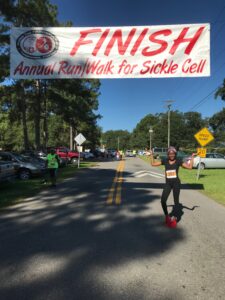
Photo courtesy Tiara Byrd
Between 70,000 and 100,000 Americans are afflicted with sickle cell disease, and the vast majority of them are of African descent, according to hematology.org. The current life expectancy for sickle cell disease patients is mid-40s, per the latest Cooperative Study of Sickle Cell Disease.
A breakthrough gene therapy treatment, a bone marrow transplant or BMT, offers a solution. The treatment involves completely destroying the sickle cell patient’s bone marrow and immune system and replacing it with healthy bone marrow from a donor, typically a sibling.
Dr. Kamar Godder has worked in pediatric hematology and oncology since 1988 and is board certified in the practice. Godder is the medical director of the BMT team at Nicklaus Children’s Hospital in Miami and has worked with countless families who seek a cure.
Godder said, “If you have sickle cell, you have a choice. You have a choice of life-long suffering or potential to cure.”
There are risks associated with the transplant that come with destroying the immune system and implanting foreign bone marrow. These include infections, medication side effects and the patient’s body rejecting the transplanted bone marrow. The final risk can turn into an ailment called graft-versus-host disease or GVHD and prolongs the patient’s recovery period.
Yet, Godder has implemented and observed more fine-tuning in the BMT process per each patient, each disease and each donor. Every case is different from the last and Godder has witnessed more success.
“A successful transplant is a transplant where you have, when we replaced old bone marrow with healthy bone marrow, when the original disease does not come back, there are not too many long-term side effects and the immune system is completely recovered,” added Godder.
Tiara Byrd is a senior psychology major at Florida A&M University afflicted with sickle cell disease. Byrd is 21 years old and sticks to strict treatments, regimens and routines as to not trigger the painful symptoms of sickle cell disease.
“As a child, I was very lucky, I have a very good support system,” said Byrd. “It wasn’t until college that I experienced very severe pain crises, very often.”
Suffering from pain crises, a bout with pneumonia and acute chest syndrome throughout her life initially made Byrd’s transition out of Jacksonville to independence tough. Byrd’s history with sickle cell anemia makes her eligible for BMT. Both parents have the sickle cell trait, leaving Byrd with a severe form of the disease.
“It is an option for sickle cell patients like myself. But like I said, growing up — I had a very good support system and even being in the church — I can say that the Lord has blessed me with this for a reason. And my reason is to be the voice for sickle cell, especially on FAMU’s campus,” said Byrd.
The risks and rewards of BMT are something that Byrd has full understanding of. Through her organization, Zeta Phi Beta sorority, Byrd holds events to raise awareness for the disease and options that patients have.
“It’s a beautiful opportunity for people who are able to do it,” Byrd said. “I don’t necessarily want to get rid of my curse/blessing/gift.”
September is National Sickle Cell Awareness Month. Visit cdc.org for more on sickle cell disease, BMT and how to help raise awareness.